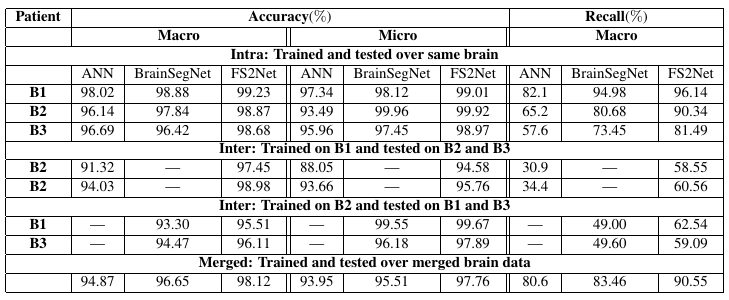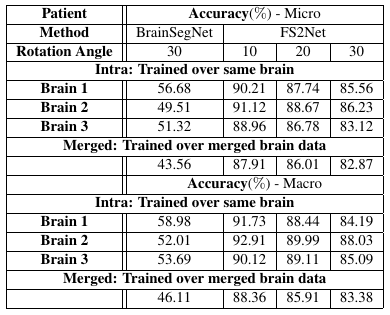Siamese LSTM-based fiber structural similarity network (FS2NET) for rotation invariant brain tractography segmentation
Motivation
- Streamline classification usually requires registration of subject data to a common space.
- Contribution: The main goal of this work is to provide a rotationally invariant approach for streamline segmentation based on a set of reference streamlines.
Main idea
- Learn the probability of two streamlines to belong to the same bundle.
- Recognise a streamline by assigning the label of the fiber with the highest similarity in a given set of reference fibers.
Rotation invariance
-
Assumption: Similarity between fibers is learned. This is supposed to generalise to
a. misaligned
b. rotated
streamlines.
-
Therefore, applying data augmentation to the reference set is sufficient for achieving rotation invariance. (I.e. augmentation independent of the training stage.)
Method
-
FS2Net:
- stacked LSTMs to arrive at a 32-entry feature vector
-
“L1-distance” between feature vectors
Comment: Probably, the authors mean the difference vector.
- classification network: ‘similar’ vs ‘dissimilar’

Experiments
-
Comparison to two of their own works: ANN and BrainSegNet
- Comment: Doubtful if this can be considered as ‘state of the art’.
-
Training:
- BS: 11, 1000 batches per epoch -> only 11K training samples. # epochs: not clear.
Nomenclature
-
macro classification - Gray matter fibres vs White matter fibres
- probably: U-shaped or short fibres vs long range fibres (?)

-
micro classification - Labelling WM fibres into 8 subclasses
-
Recall - fraction of correct WM labels in macro classification
Data
- 3 subjects, 250K streamlines each
- preprocessing: keep only 75% of streamline points with the highest curvature (per fibre)
- each streamline: max of 100 points (zero padded)
Registered data
- FS2Net achieves top performance compared to ANN and BrainSegNet in all experiments.
- FS2Net shows better recall hinting at a better robustness towards data imbalance of GM and WM classes (macro).

Unregistered data
- FS2Net is quite robust to rotations of testing streamlines.

Comment
- Very nice idea. However, for the real value of their approach for streamline segmentation the evaluation is of limited power.